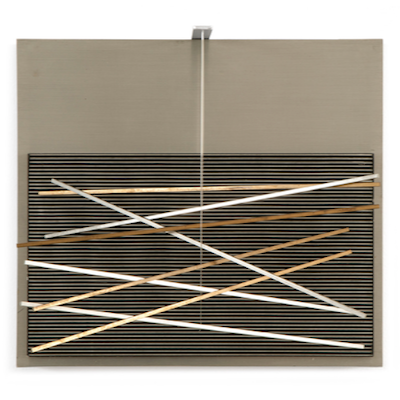
Details
Artist
Styles
// Koskota by Victor Vasarely, created in 1976, is a striking silkscreen print that demonstrates Vasarely’s innovative approach to Op Art. This limited edition piece, with an edition size of 250, features a spherical form that appears to float against a gradient blue background. The central sphere, composed of a grid of diamond-shaped patterns in warm tones of orange and brown, contrasts sharply with the cool blues of the background, creating a vivid sense of depth and dimensionality. The geometric patterning and Vasarely’s use of color gradients make the sphere seem to bulge outward, challenging the viewer’s perception of space and form. Koskota exemplifies Vasarely’s skill in using simple shapes and colors to create complex visual effects that engage the viewer’s eye, transforming the two-dimensional surface into a dynamic and immersive experience.
Koskota, 1976
form
Medium
Size
78.7 x 70 cm
- Inches
- Centimeters
Edition
Price
- USD
- EUR
- GBP
Details
Artist
Styles
// Koskota by Victor Vasarely, created in 1976, is a striking silkscreen print that demonstrates Vasarely’s innovative approach to Op Art. This limited edition piece, with an edition size of 250, features a spherical form that appears to float against a gradient blue background. The central sphere, composed of a grid of diamond-shaped patterns in warm tones of orange and brown, contrasts sharply with the cool blues of the background, creating a vivid sense of depth and dimensionality. The geometric patterning and Vasarely’s use of color gradients make the sphere seem to bulge outward, challenging the viewer’s perception of space and form. Koskota exemplifies Vasarely’s skill in using simple shapes and colors to create complex visual effects that engage the viewer’s eye, transforming the two-dimensional surface into a dynamic and immersive experience.
- Recently Added
- Price (low-high )
- Price (high-low )
- Year (low-high )
- Year (high-low )
What is kinetic art?
Kinetic art is an international movement that emerged in the 1920s and gained prominence in the 1960s, referring to art that involves both apparent and real motion. It encompasses any medium that includes movement, either relying on actual motion for its effect or being perceived as moving by the viewer. Early examples include canvas paintings designed to create optical illusions of movement. Today, kinetic art often refers to three-dimensional figures and sculptures, such as those operated by machines or those that move naturally. The movement covers a variety of styles and techniques that frequently overlap.








































































